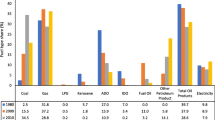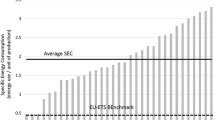Abstract
This article develops a decomposition of inter-country differences of unit energy costs (UEC) of the manufacturing sector. UEC are decomposed into a structural (industry-mix) component and an autonomous component that captures all other effects like, e.g., differences in energy efficiency and energy prices. Based on NACE 3-digit level data from Eurostat’s Structural Business Statistics the industry-mix component can be quantified on different levels of sectoral disaggregation. The results show that not only industry-mix effects on the conventional (typically NACE 2-digit) but also those measurable at higher levels of disaggregation are relevant for comparison of energy costs across countries.

(Source: Eurostat Structural Business Statistics, own calculations and presentation)
Similar content being viewed by others
Availability of data and materials
The dataset used in this analysis is available in raw form from Eurostat Structural Business Statistics https://ec.europa.eu/eurostat/web/structural-business-statistics. The data set as used for the analysis as well as a description of the data preparation steps is available from the corresponding author upon reasonable request.
Notes
Therefore, as a first data preparation step, one could normalize the data by dividing all defined variables by \({X}_{i}\) and conduct the analysis as described, with identical results. After the normalization we would have \({X}_{i}=1\) and \({E}_{i}={e}_{i}\). This could possibly ease the comparison across countries in the context of the decomposition analysis.
All in all, 17 cases of missing data values, due to, among other things, secrecy regulations, were identified. A description of the steps taken to amend these cases as well as a general description of the data preparation and the data set used for the analysis are available on request.
A recent study of energy costs in Germany and Europe (Kaltenegger et al 2017) defines unit energy costs as the ratio of energy costs to value added. While this approach might have some merits, we chose our definition in analogy to the definition of unit labour costs, which are usually defined as labour costs divided by gross output (see also the OECD Glossary of Statistical Terms, https://stats.oecd.org/glossary/index.htm).
The lower UEC of Italy in comparison with other countries seems to be exclusive to this data source, SBS, as this is not present in other data sources, such as Eurostat supply and use tables. In SBS this property is observed throughout most of 2-digit level industries at least since 2011. Possible explanations, apart from different energy prices and energy efficiency, include institutional settings that influence how energy taxes, supply of renewable energy, definition of energy from own production etc. are captured by the statistical survey which forms the national base for SBS.
Suppose we perform decomposition analyses to decompose differences between A and B, A and C, and B and C, respectively. Then the circularity test fails (in the case of additive decomposition) if adding each component of the decomposition between A and B with the corresponding component of the decomposition of differences between B and C does not provide the same results as the decomposition of changes between A and C. In decomposition analysis over time, failing the circularity test is usually less problematic than in decomposition analysis over cross-section because time has a natural order and usually only a few years are selected for comparison. Cross-section decomposition analysis involves potentially many countries (or other entities) to compare and failing the circularity test forces the researcher to choose between ways to compare between them. In our application this is not so problematic, as Germany is the largest economy of EU-Europe and can therefore be given the privilege of the “hub” for every comparison.
Note that this autonomous effect might still contain industry-mix effects, which one could possibly isolate, if more detailed data on the 4-digit level and beyond were evaluated.
Abbreviations
- UEC:
-
Unit energy cost
- NACE:
-
Nomenclature statistique des activités économiques dans la Communauté européenne
- IDA:
-
Index decomposition analysis
- SDA:
-
Structural decomposition analysis
- SBS:
-
Structural Business Statistics
References
Alcántara V, Duarte R (2004) Comparison of energy intensities in European Union countries. Results of a structural decomposition analysis. Energy Policy 32:177–189. https://doi.org/10.1016/S0301-4215(02)00263-X
Ang BW, Zhang FQ (2000) A survey of index decomposition analysis in energy and environmental studies. Energy 25:1149–1176. https://doi.org/10.1016/S0360-5442(00)00039-6
Ang BW, Xu XY, Su B (2015) Multi-country comparisons of energy performance: the index decomposition approach. Energy Econ 47:68–76. https://doi.org/10.1016/j.eneco.2014.10.011
Chen Y-Y, Wu J-H (2008) Simple Keynesian input–output structural decomposition analysis using weighted Shapley value resolution. Ann Reg Sci 42:879–892. https://doi.org/10.1007/s00168-007-0192-9
De Boer P, Rodrigues JDF (2019) Decomposition analysis: when to use which method? Econ Syst Res 32:1–18. https://doi.org/10.1080/09535314.2019.1652571
De Nooij M, van der Kruk R, van Soest DP (2003) International comparisons of domestic energy consumption. Energy Econ 25:359–373. https://doi.org/10.1016/S0140-9883(02)00100-7
Dietzenbacher E, Los B (1998) Structural decomposition techniques: sense and sensibility. Econ Syst Res 10:307–323. https://doi.org/10.1080/09535319800000023
Dietzenbacher E, Los B (2000) Structural decomposition analyses with dependent determinants. Econ Syst Res 12:497–514. https://doi.org/10.1080/09535310020003793
Hammond GP, Norman JB (2012) Decomposition analysis of energy-related carbon emissions from UK manufacturing. Energy 42:220–227. https://doi.org/10.1016/j.energy.2011.06.035
Kaltenegger O, Löschel A, Baikowski M, Lingens J (2017) Energy costs in Germany and Europe: an assessment based on a (total real unit) energy cost accounting framework. Energy Policy 104:419–430. https://doi.org/10.1016/j.enpol.2016.11.039
Koller W, Stehrer R (2010) Trade integration, outsourcing and employment in Austria: a de-composition approach. Econ Syst Res 22:237–261. https://doi.org/10.1080/09535314.2010.493504
Shorrocks AF (2013) Decomposition procedures for distributional analysis: a unified framework based on the Shapley value. J Econ Inequal 11:99–126. https://doi.org/10.1007/s10888-011-9214-z
Xu XY, Ang BW (2013) Index decomposition analysis applied to CO2 emission studies. Ecol Econ 93:313–329. https://doi.org/10.1016/j.ecolecon.2013.06.007
Acknowledgements
The authors would like to thank the Anniversary Fund of the Oesterreichische Nationalbank for supporting the project under project number 17040. The usual disclaimer applies.
Author information
Authors and Affiliations
Contributions
All authors have equally contributed to designing the research, data collection and preparation, performing the analysis as well as writing the manuscript. All of the authors have read and approved the final manuscript.
Corresponding author
Ethics declarations
Conflict of interest
The authors declare that they have no competing interests.
Additional information
Responsible Editor: Brigitte Hochmuth.
Publisher's Note
Springer Nature remains neutral with regard to jurisdictional claims in published maps and institutional affiliations.
Appendix 1: Methodology: decomposition of industry-mix and autonomous effects on 2nd- and 3rd-level
Appendix 1: Methodology: decomposition of industry-mix and autonomous effects on 2nd- and 3rd-level
Both industry-mix effects, \({\Delta }_{{{\bar{\mathbf{B}}}}} e\) and \({\Delta }_{{{\mathbf{\bar{\bar{B}}}}}} e\), can be further decomposed in the following manner. Introducing the matrices \({\bar{\mathbf{B}}}^{j}\) and \({{\bar{\bar{\mathbf{B}}}}}^{m}\), where \(m=1,\dots K\), for which the \(j\)-th respectively the \(m\)-th column corresponds to the respective column in \({\bar{\mathbf{B}}}\) as well as \({{\bar{\bar{\mathbf{B}}}}}\) and all other columns include exclusively zero-values, allows to extend the decomposition model:
and
These decompositions allow distributing industry-mix effects between the energy-intensive and non-energy-intensive industry or attributing it to specific sectors at the NACE 2-digit level. A further modification of the decomposition model allowing to calculate the decomposition given in Eq. (9) as well as a decomposition of the autonomous effect, \({\Delta }_{{{\mathbf{\bar{\bar{e}}}}}} e\), is based on the diagonalisation of \({\mathbf{\bar{\bar{e}}}}\). Let \(\varvec{\bar{\bar{E}}}\) be a matrix with the main diagonal \(\varvec{\bar{\bar{e}}}\) and all other elements being zero. This allows rearranging the decomposition model in Eq. (6) as follows:
where \(\widetilde{\mathbf{e}}\) is a vector of length \(L\) and sum \(e\) whose m-th element gives the additive contribution of the m-th 3-digit level sector to the overall UEC. Equation (10) would also allow decomposing the industry-mix effects according to the contribution of industries and subindustries. Nevertheless, a more disaggregated decomposition of industry-mix effects than the one available by Eqs. (8–9) is not possible because the vectors \(\mathbf{b}\), \({\bar{\mathbf{b}}}_{j}\) und \({{\bar{\bar{\mathbf{b}}}}}_{jk}\) are vectors with shares as elements, which must sum up to 1, such that the elements are not independent of each other. Dependent components in decomposition analysis must be treated with caution (cf. Dietzenbacher and Los 2000). This is why Eqs. (8–9) are used for decomposing the industry-mix effects and only the autonomous effect is decomposed according to the diagonalisation approach given in Eq. (10).
Rights and permissions
Springer Nature or its licensor (e.g. a society or other partner) holds exclusive rights to this article under a publishing agreement with the author(s) or other rightsholder(s); author self-archiving of the accepted manuscript version of this article is solely governed by the terms of such publishing agreement and applicable law.
About this article
Cite this article
Koller, W., Eder, A. & Mahlberg, B. Industry-mix effects at different levels of sectoral disaggregation: a decomposition of inter-country differences in energy costs. Empirica 50, 883–897 (2023). https://doi.org/10.1007/s10663-023-09593-w
Accepted:
Published:
Issue Date:
DOI: https://doi.org/10.1007/s10663-023-09593-w




